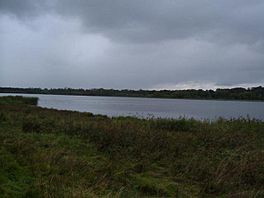Aqualate Mere facts for kids
Quick facts for kids Aqualate Mere |
|
|---|---|

(2004)
|
|
| Location | Staffordshire, England |
| Coordinates | 52°46′52″N 2°20′21″W / 52.7812°N 2.3392°W |
| Type | mere |
| Basin countries | United Kingdom |
| Settlements | Newport, Shropshire |
Aqualate Mere is the biggest natural lake in the English Midlands. It is located in Staffordshire, England. This special lake is looked after by Natural England as a National Nature Reserve (NNR). This means it's a protected area for wildlife and nature.
Contents
Where is Aqualate Mere?
The Mere is found in the Stafford area of Staffordshire. It is about 3 kilometers (2 miles) east of the town of Newport, Shropshire. The lake is part of the large estate of Aqualate Hall, which is a historic country house. The hall has beautiful gardens and an old deer park around it.
How Big and Deep is it?
Aqualate Mere is quite long, about 1.5 kilometers (almost 1 mile). It is also about 0.5 kilometers (0.3 miles) wide. Even though it's big, the lake is very shallow. It's usually not much deeper than one meter (about 3 feet). You could almost stand up in most of it!
How was the Mere Formed?
Aqualate Mere was formed a very long time ago. It was created by melting ice from a glacier during the last Ice Age. This was called the Devensian glaciation. The lake sits in a dip in the ground, which scientists think is a "kettle hole." This hole was made when a large block of ice melted and left a hollow. The sandy and gravelly hills around the lake were also formed by the glacier at the same time.
Water Flow
Streams from the north, south, and east flow into Aqualate Mere. One of these streams is called Back Brook. The water then flows out of the Mere from the west. This outflow forms the River Meese. The River Meese then joins the River Tern, which is a smaller river that flows into the larger River Severn.
Amazing Wildlife
Aqualate Mere is a very important place for many different kinds of wildlife.
Fish and Birds
The lake is home to many types of fish. It's also a fantastic spot for bird watching. Lots of wildfowl (like ducks, geese, and swans) come here in the winter. Many also choose to breed here. You might also see Eurasian curlew and common snipe nesting around the lake.
Plants and Insects
The land around the Mere is special for its different plants. It also has many kinds of invertebrates, which are creatures without backbones, like insects and spiders.
Mammals
Several interesting mammals live in the National Nature Reserve. These include the polecat, water vole, and the tiny harvest mouse. You can also find different types of bats flying around, such as pipistrelle, Daubenton's, Natterer's, Brandt's, and whiskered bats.
What Does the Name Mean?
The name "Aqualate" comes from an old language called Anglo-Saxon. It means "oak grove." This suggests that there might have been many oak trees in the area a very long time ago.


